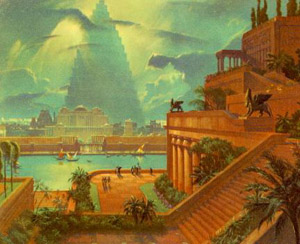Hanging Gardens of Babylon
One of the Seven Wonders of the World. The gardens, built within the walls of the royal palace at Babylon, the capital of Babylonia (now in southern Iraq), did not actually "hang" but were instead "up in the air"--that is, they were roof gardens laid out on a series of ziggurat terraces that were irrigated by pumps from the Euphrates River. Traditionally, they were the work either of the semilegendary Queen Sammu-ramat (Greek Semiramis, mother of the Assyrian king Adad-nirari III, who reigned from 810 to 783 BC) or of King Nebuchadrezzar II (reigned c. 605-c. 561 BC), who built them to console his Median wife, Amytis, because she missed the mountains and greenery of her homeland.
The Hanging Gardens were described in detail by classical authors, who related that the terraces were roofed with stone balconies on which were layered various materials, such as reeds, bitumen, and lead, so that the irrigation water would not seep through the terraces. Although no certain traces of the Hanging Gardens have been found, a German archaeologist, Robert Koldewey, did uncover an unusual series of foundation chambers and vaults in the northeastern corner of the palace at Babylon. A well in one of the vaults may have been used in conjunction with a chain pump and thus was perhaps part of the substructure of the once towering Hanging Gardens.
